Modern interior design of the kitchen-living room
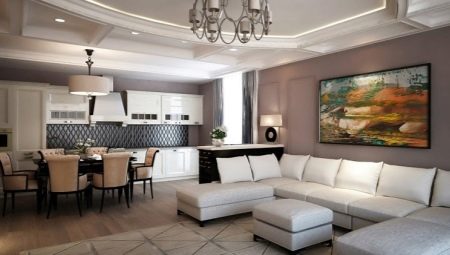
In most standard apartments, the kitchen area is far from the desired one. As a rule, housewives do not have enough space to implement all their ideas. It is especially difficult for a large family to live in an apartment with a small kitchen. Today, the modern design of the kitchen-living room is very popular. Such a stylish interior involves combining the kitchen and one of the large rooms. The combined room with the demolished wall becomes much more spacious. You can decorate the kitchen-living room in almost any style and color, it all depends on your taste and desire.

Features, advantages and disadvantages
This solution is especially important for apartments with a small area, it makes it possible to give a typical layout originality and showiness.
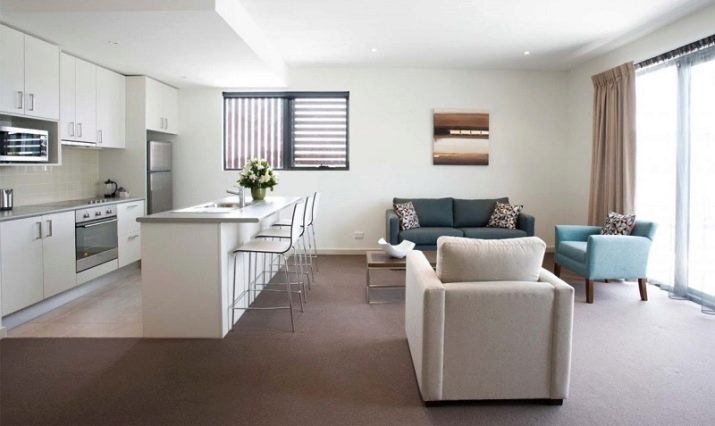
Pros.
There is more space. And not only visually, because the demolished wall gives up a few square meters for use. This place can be used rationally. Two small rooms are transformed into a large, vacant one.
More lighting. Two windows in the room provide good natural light.
Nice dining area. Unfortunately, small kitchens have to be content with tiny dining areas. In a combined project, you can place a large table, beautiful chairs. You eliminate the need to move to the living room and set the table there.
Family comfort. Cooking most often isolates the hostess, she cannot look after the children or communicate with them and her husband at this time, the association gives her such an opportunity.
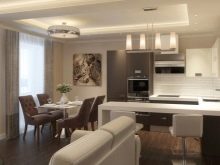
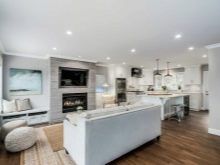
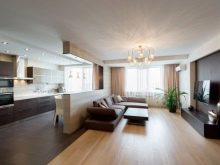
There are also disadvantages that must be taken into account:
the financial cost of such a project in comparison with conventional repairs without demolishing the walls;
the need for good quality equipment, since odors will freely "walk" around the room if the hood is bad, and noisy appliances will interfere with household members;
such repairs take quite a long time, the work is noisy;
consent is required for redevelopment, if the wall of the bearing plan is not allowed to be demolished;
if the house is equipped with gas, a partition is required by law.
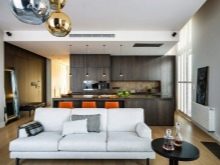

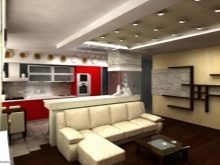
Space zoning
Combining two rooms for different purposes implies a competent separation of zones. At the same time, it is necessary that the space remains visually unified. First of all, you need to correctly arrange the furniture: move a sofa, armchairs, a TV to one zone, a dining table and chairs to another, a kitchen set, household appliances in a third. In addition, designers recommend considering different zoning methods.

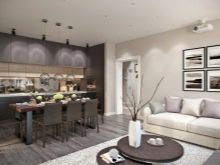
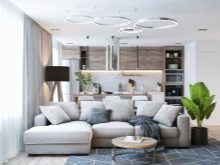
Arches
You can leave part of the remaining wall and decorate it in the same style as the room. However, this method is only good for large rooms, it steals part of the area, darkens it. An effective solution is a thin partition with an arch, decorated in glass.
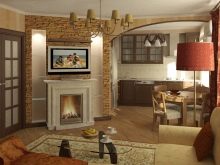
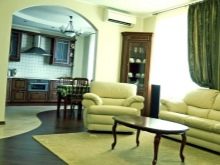

Bar counters
This is the most popular way to separate the kitchen space from the sitting area. In addition to the decorative function, the rack can be used as a table, work surface. Inside it you can place storage sections.
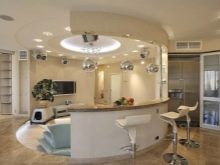
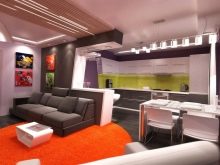
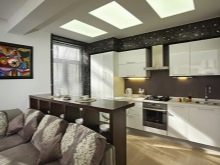
Partitions
There are different options for creating: leave part of the wall or put a thin wall with shelves, glass inserts. Usually they use drywall, plastic sliding walls, curtains made of thick fabric, aquariums, shelves with decorative flowers.
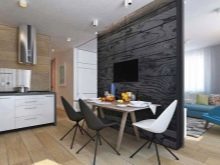
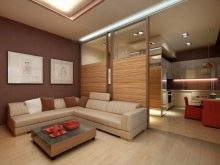

Finishing on two levels
If the ceilings are quite high, you can raise the floor in one of the zones. In addition, two-level ceilings look great. It should be remembered that when rearranging furniture, zoning using two levels will have to be dismantled, otherwise the integrity of perception will be violated.


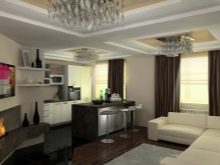
Lighting
For a kitchen-living room, it is unacceptable to use one common source of lighting. The working area, as a rule, is highlighted by spotlights, the same can be done with the bar counter. Ceiling luminaires can also be used as overhead lighting. The living room is decorated with a chandelier, floor lamps, table lamps. This will create the desired contrast.

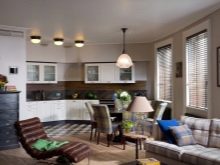

Color solutions
It is very important not only effectively, but also to correctly combine shades so that the kitchen-living room is not only divided into zones, but also uniform in composition. The designers suggest considering the following possible combinations.
Apply different tones within the same palette. For example, highlight the kitchen with more catchy colors, and decorate the living room in a neutral, calm manner.
Choose the same shades, but different bright accents. That is, decorate the room in a single light color scheme and divide the zones with different decorative elements in color.
Make the general background different, the accents are common. The most profitable solution is to choose the main colors light, but light in both zones, and the complementary and accent colors - bright and uniform.
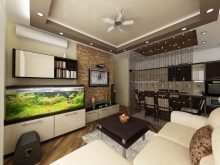
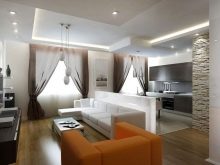
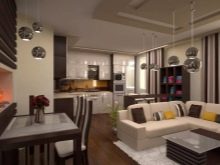
Style selection
Contemporary styles are distinguished by such features as:
functionality;
practicality;
a small amount of decor;
uncluttered space.
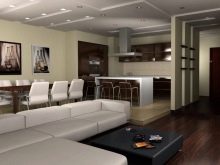

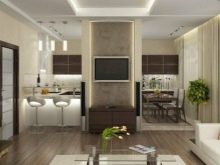
The most important thing is to choose a single direction and select the finish, furniture, decor in accordance with it. The harmonious composition does not allow mixing of styles. If you love fusion, you have to work hard learning the right combinations of details from different directions. It is easier and more efficient to stop at one. It is important that household appliances are fully consistent with the chosen style. Designers suggest considering the following options for decorating a kitchen-living room.
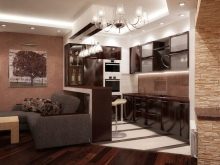

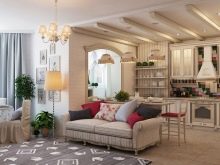
High tech
The most important thing here is to free up space as much as possible and reduce decor and accessories to a minimum. Monochrome surfaces prevail, the same finish. Metal, glass materials, gloss look harmoniously. The color scheme includes gray, black, white, brown. The silhouettes have well-defined straight lines. So that the composition does not visually look uncomfortable, you can include a soft carpet and beautiful lighting in it.
It is better to replace textiles on the window with blinds.
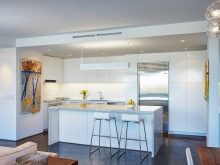

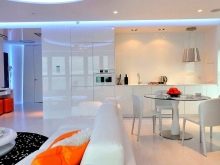
Minimalism
This style also does not involve a lot of furniture and decor. The name itself says that there should be few details. The color scheme includes shades of white, brown, gray, black, all shades of wood. Discard the flashy decor. The technique should be built-in, not conspicuous, as hidden as possible.
Exclude small elements from the composition.

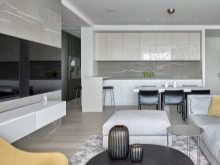
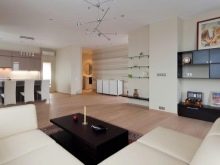
Neoclassic
Modern classics involve decorating walls, floors and ceilings in similar colors. It is better to give preference to light, neutral tones of beige, white, sand, olive. The silhouettes are straight, but not sharp, smooth. Textiles and furniture must be selected natural, soft.
The laconic design can be safely diluted with spectacular decor: books, antiques.

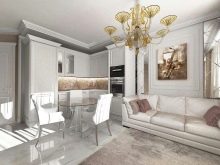
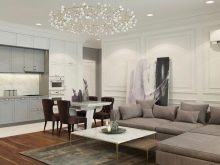
Scandinavian style
A very popular style, a characteristic feature of which is the choice of light shades for decoration, natural materials. Used wood, ceramics, stone. White predominates; black and brown are often used as accent and complementary ones. Decorative elements are not provocative, but clearly stand out against the general background: photos, paintings, plants, carpets.

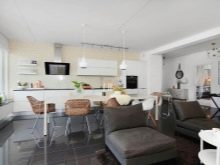
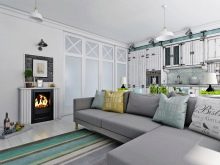
Kitsch
This is one of the most challenging contemporary styles. It involves the use of flashy details, bright colors. Most often it is blue, violet, orange, yellow, red shades. It is better to choose furniture of complex shapes, non-standard.
To prevent the overall composition from being too chaotic and difficult to perceive, it is better to arrange the background in light shades.

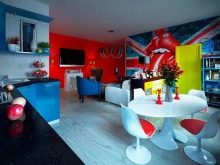
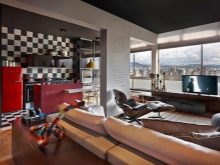
Country
This style is extremely cozy and soft, it combines simplicity, naturalness and functionality. You should not use metal, plastic, synthetic elements in a kitchen-living room of this style. Natural colors: brown, green, beige. Use gilding, burgundy, yellow, black as accents.
Wicker furniture, paintings, beautiful dishes, large clocks will ideally fit into such a room.

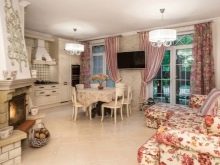
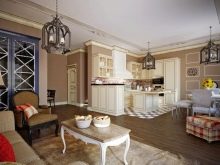
Modern design ideas for the kitchen-living room are in the video below.








